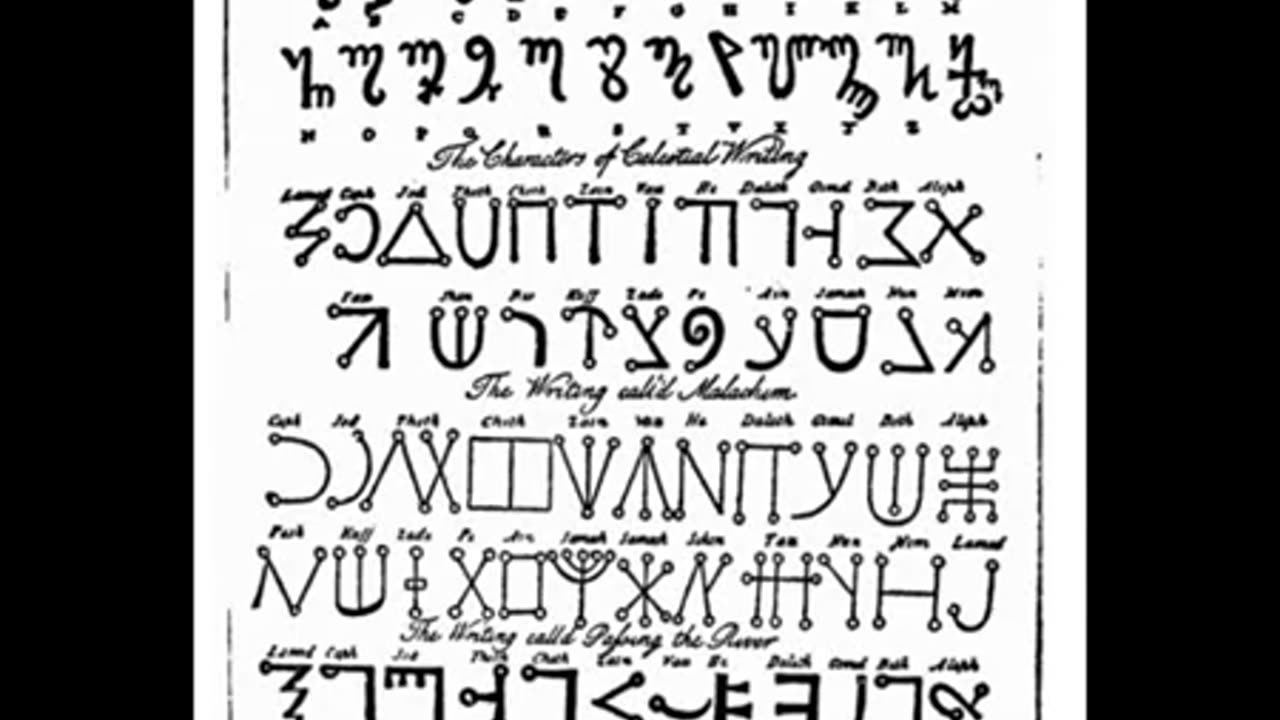Premium Only Content

The Magick Alphabet
https://solitarypaganism.com/magick/the-magick-alphabet/
It is probable that all alphabets were originally magical.
Only in later times did they come to be reduced to the more prosaic transactions of mere record and trade.
The names which the letters were given often concealed some secret, which they enshrined in an abbreviated form.
Also, the number of the letters, and their divisions into consonants and vowels, had inner and arcane meanings.
A frequent proportion found in old alphabets is that of twenty-two letters, whereof seven are vowels.
This conceals, in a rough approximation, the relation of the diameter of an Alphabet magick.
Examples of alphabets from The Magus by Francis Barrett.
Alphabets, Magical circles to their circumference, which is today mathematically expressed by the Greek letter TI.
Moreover, before numeral figures were invented, the letters of the alphabet also served for the figures of numbers, such as A = 1, B = 2, and so on.
In this way, a word or a name was also a number.
Hence the study of what is today called numerology is a very time-honored practice.
The Hebrew alphabet, in particular, contains mystic meanings in this way; and the study of these, and the use of numbers to express transcendental ideas, a kind of spiritual algebra, is called the Qabalah, meaning traditional knowledge.
This word is sometimes spelled Cabala or Kabbala.
It has become an important part of the mystic and magical tradition of the West.
The Arabic alphabet, too, is used in this way, by the Sufis and other arcane brotherhoods of the Near East.
The Greek alphabet also lent itself to such use and interpretation, in ancient times.
In Britain, the Celtic Druids made use of the Ogham alphabet, which had several forms.
These have been studied extensively in our day by Robert Graves, in his now famous book, The White Goddess (Faber and Faber, London, 1 961).
He found them to throw a flood of new light upon the religion of Ancient Britain, and to show among other things that Britain was by no means a benighted and savage region, as often
previously taught, but a country in touch with the philosophy and religion of the greater part of the ancient world.
When the Angles and Saxons and the rest of the northern invaders settled in these islands, and Celtic Britain became Anglo-Saxon England, another magical alphabet found its way to this country.
This was the Runic alphabet, or Futhork (so-called from its first six letters).
This alphabet has given us the word ‘rune’, meaning a magical rhyme.
Originally, the Runes were the letters it was written down in.
Each of the Runic letters had a magical meaning.
Runic inscriptions were cut upon the hilt of a warrior’s sword, to make it powerful and victorious in battle; and this may be the origin of the ‘magical weapons’, knives and swords with mystic sigils and inscriptions upon them, which play such an important part in medieval magic.
The magician uses such weapons to draw the magic circle and to command spirits.
Though the witches of ancient Thessaly also used short swords as magical weapons.
It was because of their connection with pagan magic that the old Ogham and Runic alphabets were regarded with disfavor by the Christian Church.
With the spread of Christianity, these old alphabets fell into disuse and were replaced by the Latin alphabet, upon which our present-day alphabet is based.
The use of Ogham, however, was continued by the Bards of Wales, in order to write down the traditional knowledge they claimed to have Amulets received from the Druids.
They also evolved their own Bardic Alphabet, for the same purpose.
The Middle Ages saw the invention of a number of secret alphabets, which were used by magicians and witches exclusively for magical purposes.
These were mostly based upon the twenty-two-letter Hebrew alphabet; though there is one, the so-called The ban Alphabet of Honorius, which is based upon the Latin alphabet.
Consequently, this is a favorite magical alphabet of the witches, whose magic generally is not Qabalistic; and the Theban alphabet is often used by them today.
It takes its name from a legendary great magician of the past, Honorius the The ban.
To write something down in a magical alphabet serves two purposes.
Firstly, it conceals the secret of what has been written and hides it from the uninitiated.
Secondly, it compels the magician or the witch to concentrate more upon what he or she is writing, because they have to use unfamiliar characters to express it.
Hence, more power of concentrated thought goes into an inscription so written and makes it more magically potent.
-
 9:21
9:21
asolitarypagan.com
1 year agoMaking Herbal Salves
1.72K -
 LIVE
LIVE
TheDailyWire
4 hours agoElection Night 2024 with The Daily Wire
5,746 watching -
 2:00:59
2:00:59
Human Events Daily with Jack Posobiec
3 hours agoHUMAN EVENTS DAILY WITH JACK POSOBIEC
67.2K1 -
 1:02:22
1:02:22
In The Litter Box w/ Jewels & Catturd
23 hours agoDEFEAT THE CHEAT: VOTE! | In the Litter Box w/ Jewels & Catturd – Ep. 684 – 11/5/2024
73.7K3 -
 1:23:48
1:23:48
Awaken With JP
2 hours agoElection Day Special LIVE UPDATE - LIES ep 64
115K39 -
 2:04:52
2:04:52
The Quartering
5 hours agoElection Day Madness Already! Voting Machines Breaking, Massive Lines & Scary Numbers For Kamala
170K33 -
 LIVE
LIVE
Badlands Media
1 day agoBadlands Media Special Coverage - The 2024 Election
28,437 watching -
 2:58:24
2:58:24
The Charlie Kirk Show
5 hours agoJudgment Day | Maloney, Galaszewski, Dittrich, Bowyer, Joecks, Baris | 11.5.24
396K103 -
 49:16
49:16
Stephen Gardner
3 hours agoBREAKING: Kamala's election scheme SURGES INTO SPOTLIGHT | Final Polling Data for Trump!
72.3K34 -
 57:11
57:11
TheMonicaCrowleyPodcast
3 hours agoThe Monica Crowley Podcast: The Final Battle with Guest Steve Bannon!
45.5K1